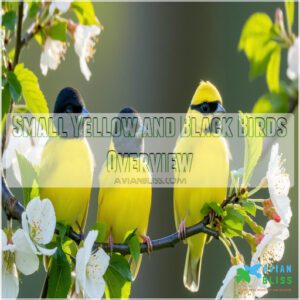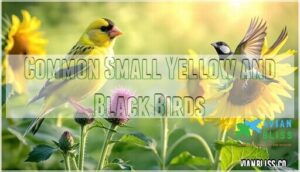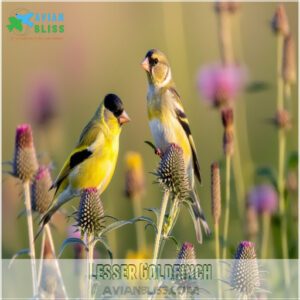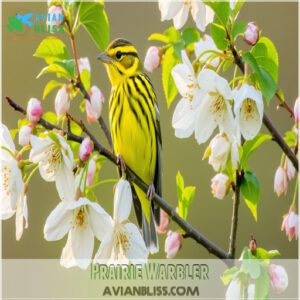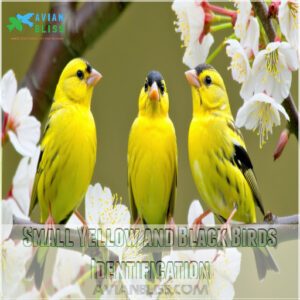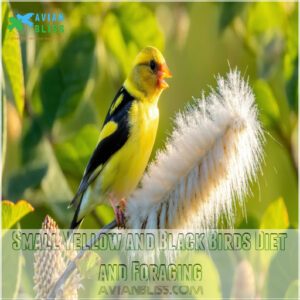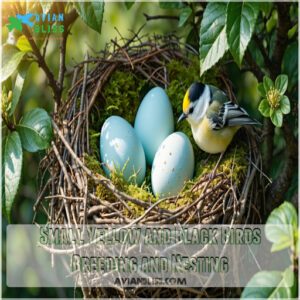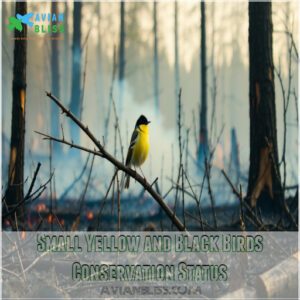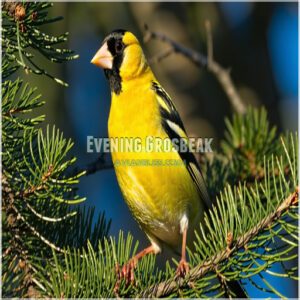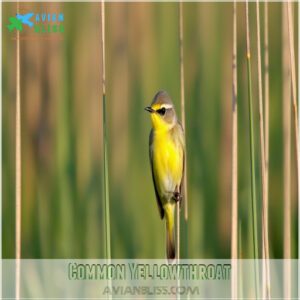This site is supported by our readers. We may earn a commission, at no cost to you, if you purchase through links.
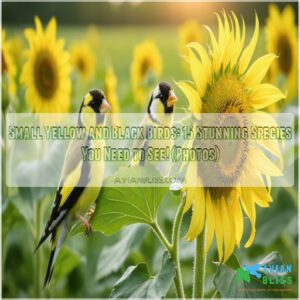
These songbirds are usually 4-5 inches long, making them tiny but eye-catching visitors. The American Goldfinch flaunts a vivid yellow body with bold black wings, while the Common Yellowthroat sports a yellow chest and a black mask, almost like a feathered bandit.
You’ll often find these birds in forests, wetlands, or your own backyard feeders. They’re social, sometimes forming flocks, and their cheerful songs make them delightful company.
With so many unique species, there’s always something new to discover about these beauties!
Table Of Contents
- Key Takeaways
- Small Yellow and Black Birds Overview
- Common Small Yellow and Black Birds
- Small Yellow and Black Birds Identification
- Small Yellow and Black Birds Diet and Foraging
- Small Yellow and Black Birds Breeding and Nesting
- Small Yellow and Black Birds Conservation Status
- Unique Small Yellow and Black Birds
- Frequently Asked Questions (FAQs)
- What does a yellow bird look like in summer?
- What bird is yellow with black wings?
- Are black and Yellow Birds common?
- What are black & yellow bird species?
- What color are black birds?
- What is the difference between yellow and black birds?
- What is the name of the little yellow and blackbird?
- What exactly does it mean to see a yellow bird?
- What is a small yellow and black bird called?
- What is the difference between a goldfinch and a yellow warbler?
- Conclusion
Key Takeaways
- You’ll identify small yellow and black birds like the American Goldfinch and Hooded Warbler by their bright plumage, unique markings, and distinct songs.
- These birds thrive in varying habitats like wetlands, woodlands, and backyards, with migration patterns impacting when and where you’ll spot them.
- Their diets include seeds, insects, and nectar, with specialized beaks and behaviors suited to their feeding needs.
- Habitat loss, climate change, and predators threaten these birds, but planting native plants and using feeders can attract and support them.
Small Yellow and Black Birds Overview
You’ll find North America’s small yellow and black birds in diverse habitats, from suburban gardens to dense forests, with most species measuring between 4 to 5 inches long.
These vibrant songbirds display distinct patterns of bright yellow bodies with black wings, faces, or caps, making them a favorite among both beginner and experienced birdwatchers, with their bright yellow and black colors being a key feature.
Physical Characteristics
Like jewels taking flight, small yellow and black birds captivate with their stunning plumage colors.
You’ll notice distinctive feather patterns, from bold wing bars to delicate streaking.
Each species shows unique beak shapes suited to their diet – from stubby seed-crackers to slender insect-catchers.
Their wing structure varies too, with some built for quick dashes and others for hovering.
Body proportions range from stocky finches to slim warblers.
Habitat and Distribution
These vibrant yellow and black birds create a tapestry of migration patterns across North American birds‘ natural ranges.
You’ll find them in diverse habitats, from dense Forest Habitats to open Grassland Ecosystems.
Several striking species are featured in this online bird guide.
- American Goldfinches inhabit weedy fields and suburban feeders, moving between breeding grounds in Canada and wintering areas in Mexico
- Yellow-Headed Blackbirds prefer western wetlands and prairie marshes
- Common Yellowthroats thrive in tangled vegetation across North America
- Lesser Goldfinches stay year-round along the West Coast and Southwest
Yellow black bird sightings peak during spring and fall migrations, which is a key time to observe these vibrant birds in their natural ranges.
Behavioral Traits
You’ll spot these small yellow and black birds doing fascinating things in your backyard.
They’re social butterflies during migration, forming tight-knit flocks for safety. Many of these striking birds have yellow and black plumage.
Watch them defend their territories with bold displays and melodic songs.
Their foraging strategies show remarkable smarts – they’ll hang upside down to snag seeds, or dart through branches catching insects.
Each species has unique calls you’ll learn to recognize.
Common Small Yellow and Black Birds
You’ll spot these small yellow and black songbirds brightening up gardens and fields across North America, with the American Goldfinch and Lesser Goldfinch being frequent visitors to backyard feeders.
From the Hooded Warbler’s striking black hood to the Prairie Warbler’s distinctive yellow belly, these birds measure just 3.5 to 5.1 inches in length and weigh less than an ounce, showcasing their small size as a notable characteristic.
American Goldfinch
Every American Goldfinch transforms your backyard into a vibrant sanctuary throughout the seasons.
In spring, males sport brilliant yellow plumage with jet-black wings for courtship displays.
Summer brings their distinctive song patterns as they gather in flocks.
Come fall, their feathers shift to olive-brown for migration, while winter sees them clustering around feeders, their specialized beak structure perfect for cracking nyjer seeds.
Lesser Goldfinch
Throughout the year, Lesser Goldfinches brighten gardens with their distinctive feather patterns of yellow undersides and black wings.
You’ll recognize these small yellow black birds by their compact size and unique beak shape designed for seed-cracking. Many similar small yellow birds share these traits.
Their song variations include sweet twitters and warbling notes.
While some populations follow set migration routes, others stay put year-round.
You’ll often spot their flock behavior around thistle and sunflower feeders.
Males display striking black caps, while females show more subtle olive-green plumage with paler undersides.
Hooded Warbler
Among small yellow black birds, the Hooded Warbler stands out with its distinctive black cap and throat that frames a brilliant yellow face.
You’ll hear its "weeta weeta weeteo" song echoing through eastern deciduous forests during breeding season.
This skilled insect hunter follows a remarkable migration path from North American woodlands to Caribbean islands, where it spends winters in dense undergrowth.
Prairie Warbler
Prairie Warblers bring their striking yellow plumage and distinctive black facial stripes to young forests and abandoned fields.
You’ll find these small yellow black birds weaving through shrubs, delivering their rising buzzy song that sounds like a tiny engine revving up.
During warbler migration, they trade their prairie habitat for Caribbean islands, and watch for their unique tail-bobbing behavior while they hunt insects in the underbrush.
Small Yellow and Black Birds Identification
You’ll find that identifying small yellow and black birds becomes easier when you know their unique features, like the American Goldfinch’s bright yellow body with black wings or the Common Yellowthroat’s distinctive black face mask.
Whether you’re watching these birds at your backyard feeder or spotting them in their natural habitats, their specific markings, sizes, and behaviors will help you tell them apart, using characteristics such as the black face mask and overall sizes.
Visual Identification
You’ll spot small yellow and black birds by their unique plumage patterns.
Look for distinctive wing bars on American Goldfinches, or the black mask of a Common Yellowthroat. Check beak shapes too – seed eaters have thick, cone-shaped bills.
Feather textures and color variations help identify species year-round. When checking images of small yellow black birds, focus on key markers like the Evening Grosbeak’s bold white wing patches or the Wilson’s Warbler’s neat black cap, including the black mask.
Song and Call Identification
Listen for the unique vocal patterns of yellow and black birds in your backyard.
The Yellow-headed Blackbird’s distinctive call sounds like a rusty gate, with males performing two types of songs: an "accent song" and a higher-pitched "buzz song."
These striking birds primarily inhabit western marshes west of the Great Lakes.
Female Yellow-headed Blackbirds match the male’s buzz song with harsh, grating sounds, and understanding these call types and song structures helps you identify these stunning birds by ear.
Nesting and Breeding Identification
When spotting a small yellow and black bird, their nests offer great clues.
These birds choose nesting spots carefully, like forests with dense understory or fields with shrubs. Nest site selection depends on safety and resources.
Breeding seasons vary, with some species starting later to match food availability. Nests often use grasses, moss, and plant fibers.
Eggs range from pale blue to speckled. Parents work hard during brood rearing, ensuring chick survival in their unique habitats.
Small Yellow and Black Birds Diet and Foraging
Small yellow and black birds eat a mix of seeds, insects, and nectar, depending on their species.
You’ll often see them foraging in fields, thickets, or even your backyard, using quick movements to spot food.
Seed-Eating Birds
Seed-eating birds are nature’s food processors, cracking seeds with precision thanks to their unique beak adaptations. These yellow-black bird species, like the American Goldfinch, Lesser Goldfinch, and Yellow-bellied Siskin, excel at turning mealtime into a show.
You can attract these birds with specially designed feeders.
- Use efficient foraging strategies to find seeds in fields or feeders.
- Play a key role in seed dispersal, helping plants grow in new areas.
- Prepare for bird migration by hoarding seeds.
- Master selective feeding habits, choosing high-energy seeds.
- Adapt to different environments using expert seed-handling techniques.
Watching these small yellow-black bird diets evolve is an amazing glimpse into nature’s survival tactics.
Insectivorous Birds
Insectivorous yellow and black birds, like Wilson’s and Hooded Warblers, are experts at pest control.
Their sharp beak adaptations and agile flying patterns help them catch insects mid-air.
Specialty insectivorous bird food is available for supplemental feeding.
These small yellow black bird species use feather camouflage to blend into habitats, ensuring survival during bird migration.
Spotting them foraging is exciting for yellow black bird identification enthusiasts!
Nectar-Feeding Birds
Nectar feeders, like the Western Tanager and Orchard Oriole, sip sweet nectar using specialized tongues.
These flower visitors help pollinate plants while enjoying blooms like fuchsias.
Adding sugar water to hummingbird feeders attracts more species.
Pollen eaters, including the Common Yellowthroat and American Goldfinch, may also visit gardens, showcasing nature’s delicate balance of energy exchange between birds and flowers.
Small Yellow and Black Birds Breeding and Nesting
When it’s breeding season, small yellow and black birds find mates and defend their territories with clear songs and displays.
They carefully build nests in shrubs, trees, or grasses, creating safe spaces to lay and protect their eggs.
Territorial Behavior
Territory marking is a must-see in small yellow and black bird behavior.
Watch them guard nests and feeding spots with impressive agonistic behavior, like chasing rivals or vocal outbursts.
Border disputes happen often, especially during yellow black bird migration.
Males also focus on resource defense and mate guarding, protecting their patch in weedy fields, forests, or meadows.
Mating and Pair Bonding
Courtship rituals in small yellow and black birds are fascinating to watch.
These displays, like singing or fluttering wings, help in mate selection and pair bonding.
Many species, including those with monogamy patterns, rely on these breeding habits to strengthen their partnerships.
Hormonal fluctuations in birds influence these avian reproductive processes.
These behaviors guarantee successful reproduction, aiding yellow black bird migration and the survival of baby birds through attentive parenting.
Nest Construction and Egg Laying
Nest-building is a skill these small yellow and black birds have mastered.
They gather nest materials like twigs, grasses, and fibers to create cozy, hidden homes.
Ideal nesting sites include trees, shrubs, and reeds near water.
Eggs vary in shape, often pale or speckled.
Typical clutch size is 3-5 eggs, with an incubation period of 11-14 days.
Parents fiercely protect the nest, ensuring baby small yellow black birds stay safe and nurtured.
Small Yellow and Black Birds Conservation Status
You mightn’t realize it, but habitat loss, climate change, and other threats are putting pressure on many small yellow and black bird species.
Understanding their conservation status can help you see why protecting their environments matters.
Threats to Populations
Small yellow and black bird conservation faces tough challenges today.
These include:
- Climate Shift: Rising temperatures disrupt yellow black bird migration and breeding cycles.
- Pollution Effects: Pesticides poison their food and water sources.
- Invasive Species: Predators, like rats, invade small yellow black bird habitats, causing fragmentation impact.
Understanding these threats helps us safeguard their habitats amidst human activities.
Habitat Loss and Fragmentation
Urbanization effects leave fragmented landscapes, harming small yellow black bird habitats.
Habitat destruction, like vanishing wetlands, pushes species such as the Yellow-headed Blackbird to the brink.
These disruptions cause ecosystem imbalances and biodiversity loss.
You can help bird conservation by supporting restoration projects, creating wildlife corridors, and protecting bird habitats to ensure small yellow black bird conservation.
Every action counts in ensuring these ecosystems are preserved for future generations!
Climate Change Impacts
Climate change is turning life upside down for small yellow and black birds.
Temperature shifts and weather extremes mess up their migration patterns and breeding cycles. Food sources vanish, and sea level changes disrupt habitats.
Here’s how:
- Ecosystem disruption exposes them to new predators.
- Food mismatches affect breeding success.
- Weather changes complicate bird migration patterns.
- Global warming causes yellow black bird sightings to decline.
Unique Small Yellow and Black Birds
You’ll find some truly fascinating yellow and black birds that stand out with features like vivid plumage and striking patterns.
Species like the Western Tanager, Evening Grosbeak, and Common Yellowthroat bring a splash of color to forests, fields, and backyards.
Western Tanager
Spotting a Western Tanager feels like finding treasure in the wild.
Their bold plumage—yellow bodies, black wings, and fiery red heads—brightens any forest.
These birds thrive in open conifer forests.
| Feature | Detail | Location |
|---|---|---|
| Western Migration | Spring to fall | Canada to Mexico |
| Tanager Diet | Insects, fruits | Forest habitats |
| Breeding Habits | High tree nests | Coniferous forests |
Learn their song patterns and observe these stunning small yellow black birds in action!
Evening Grosbeak
Ever noticed the Evening Grosbeak flaunting its striking feather patterns? These black and yellow birds stand out with their sturdy beak structure, perfect for cracking seeds like sunflower or safflower.
They often travel in large flocks, showcasing unique flock behavior during migration routes in search of food. Evening Grosbeaks nest high in trees, making spotting them a delightful challenge.
To draw them closer, consider offering specialized feeders filled with their favorite seeds. Unlike smaller yellow black bird types, they’re larger but just as vibrant as the American Goldfinch.
Protecting their habitats keeps these song variations alive in our skies!
Common Yellowthroat
The Common Yellowthroat is a standout among small yellow black birds.
With its bold black mask and bright yellow feathers, it thrives in dense, low vegetation like marshes and grasslands.
This yellow black bird type primarily feeds on insects, using its sharp beak to forage.
Known for fascinating song variations, it migrates across vast areas, inspiring bird migration enthusiasts.
Feather patterns and unique beak shapes make it a favorite in yellow black bird identification.
Frequently Asked Questions (FAQs)
What does a yellow bird look like in summer?
Imagine: in summer, yellow birds glow like tiny suns.
They’ve bright yellow bodies, black wings, and caps.
Males look vibrant, while females wear softer shades.
You’ll spot them flitting through fields or suburbs.
What bird is yellow with black wings?
You’re likely describing the American Goldfinch.
Males in summer are bright yellow with striking black wings and tail.
Females are duller, but still yellowish.
Watch for these cheerful birds flitting around fields and feeders!
Are black and Yellow Birds common?
You’ll spot black and yellow birds more often than some think.
They thrive in open fields, backyards, and parks across North America.
These tiny, vibrant wonders brighten spaces with their bold colors and active flocks.
What are black & yellow bird species?
You’ll find striking black and yellow birds like the American Goldfinch, Yellow-headed Blackbird, Scott’s Oriole, and Hooded Warbler.
Their bright patterns stand out, often inhabiting open fields, wetlands, or wooded areas across North America, which is home to a variety of species including the Yellow-headed Blackbird.
What color are black birds?
Blackbirds aren’t just black—they often have shades of brown, deep blue, or iridescent highlights.
Some, like red-winged blackbirds, have bright-colored patches on their wings, adding a pop of color to their otherwise dark appearance, which can include shades of brown.
What is the difference between yellow and black birds?
Yellow and black birds are nature’s artwork!
Yellow birds stand out with sunny plumage, symbolizing energy, while black birds often have glossy feathers, blending mystery with elegance.
Their contrasting habitats, diets, and behaviors enrich biodiversity uniquely.
What is the name of the little yellow and blackbird?
The American Goldfinch is a small yellow and black bird.
Males showcase vibrant yellow feathers with black wings and a cap, especially in summer.
Females are duller, blending olive tones for a subtler appearance.
What exactly does it mean to see a yellow bird?
Seeing a yellow bird might symbolize joy, positivity, or renewal, like nature’s way of reminding you to embrace life’s brighter moments.
Scientically, it could simply mean you’re observing a bird thriving in its natural habitat, which relates to the concept of renewal.
What is a small yellow and black bird called?
You’re likely thinking of goldfinches or yellow warblers.
Goldfinches wear bright yellow with black caps and wings, while warblers sport softer yellow tones with black markings, making them stand out in fields and backyards.
What is the difference between a goldfinch and a yellow warbler?
Goldfinches flaunt bright yellow bodies with black wings and caps.
You’ll find goldfinches in open spaces, but warblers prefer wooded areas and dense shrubs.
Yellow warblers sport sunnier yellow feathers with faint reddish streaks.
Conclusion
Picture your garden alive with the bright flashes of small yellow and black birds flitting between trees.
These colorful creatures, from the cheerful American Goldfinch to the lively Common Yellowthroat, bring energy and balance to ecosystems with their unique behaviors.
By identifying their markings, songs, and habits, you can understand their role in nature.
Invite them into your backyard with feeders or native plants, and you’ll enjoy their beauty while supporting their survival.
Nature thrives when we notice.
- https://www.birdsandblooms.com/birding/bird-photography/yellow-and-black-birds/
- https://a-z-animals.com/animals/birds/bird-facts/yellow-and-black-birds/
- https://www.birdwatchingdaily.com/beginners/birding-faq/yellow-and-black-birds/
- https://www.animalspot.net/black-and-yellow-birds
- https://www.allaboutbirds.org/guide/American_Goldfinch/id

